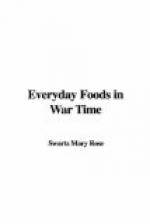The first step in food economy (aside from saving of waste) is to emphasize the use of cereal foods. As much as one-fourth the food money may be invested in grain products without nutritive disadvantage. But this is not the last word on the subject, since cereal foods, while cheap, differ among themselves in cost and somewhat in nutritive value. It is possible to confine one’s choice to some which contribute little besides fuel to the diet, such as rice and white flour, or to include those which are rich in other essentials, such as oatmeal. It is difficult to express briefly this difference in foods in any concrete fashion, but recently a method of grading or “scoring” foods has been introduced which may help to make clearer the relationship between nutritive value and general economy.
We cannot live exclusively upon foods which furnish nothing but fuel, though fuel is the largest item in the diet and one which in an effort to economize is apt to fall short; hence a food which furnishes nothing but fuel will not have as high a “score” as a food which will at the same time supply certain amounts of other essentials, such as protein, calcium (lime), iron, and the like. By giving definite values to each of the dietary essentials taken into consideration and comparing the yield of these from different foods, we may have such a score as follows:[1]
Grain Score value products per pound
White flour 1,257 Graham flour 2,150 Rye flour 1,459 White bread 1,060 Graham bread 1,525 Cornmeal 1,360 Oatmeal 2,465 Cream of wheat 1,370 Hominy 1,147 Corn flakes 1,090
[1] For the method of calculation
and further data see “The
Adequacy
and Economy of Some City Dietaries” by H.C.
Sherman
and
L.H. Gillett, published by The New York Association
for
Improving
the Condition of the Poor, 105 East Twenty-second
Street,
New York City, from which these figures are taken.
By comparing the score with the price per pound we can easily see which contributes most to the diet as a whole for the money expended. Thus, if hominy and oatmeal cost the same, the oatmeal is more than twice as cheap because we not only get a little more fuel from it but we also get protein, calcium, iron, and phosphorus in considerably larger amounts; that is, we shall need less of other foods with oatmeal




